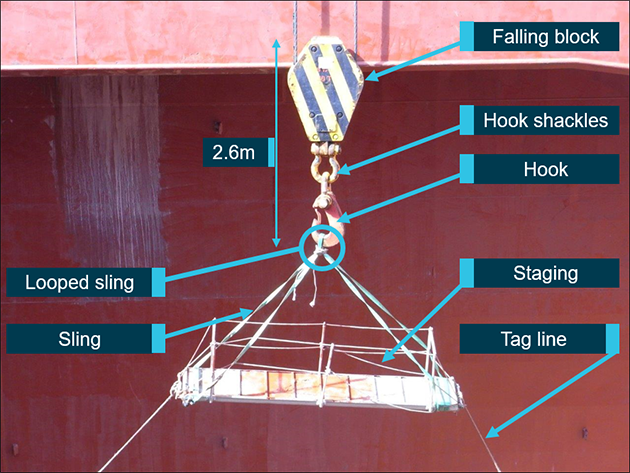
(Source: ATSB)
The ATSB is highlighting the importance of following procedures and applying best practice after two crewmen working aloft on a bulk carrier were seriously injured.
On 11 January 2018, bulk carrier Berge Daisetsu was berthed in Portland, Victoria. A team of six crewmembers were cleaning and painting the cargo hold under the supervision of the chief mate. While the vessel did not have portable scaffolding equipment or approved suspended access platforms for this task, the master discussed other options with the chief mate and bosun for how the upper sections of the hold could be tended to.
The decision was made to jury-rig a portable gangway into a work stage which could then be suspended from the cargo crane hook via slings. The ship’s crewmembers had several discussions, made plans and completed a risk assessment in accordance with the safety management system requirements. However, the equipment and machinery use was contrary to company policy and procedures.
As two crewmembers worked aloft on the platform suspended from the cargo crane, the crane’s block caught on the coaming and suddenly came free, sending an unexpected heavy shock into the platform. The two crewmembers were knocked over by the force of the sudden movement and landed heavily on their knees and lower body, causing serious injury.
The equipment and machinery were not suitable for the task, and their use made hazard identification difficult and exposed the workers to increased risk
The ATSB investigation found that the equipment and machinery were not suitable for the task, making hazard identification difficult, and exposed the workers to increased risk.
“This accident illustrates the consequence of deviating from accepted safety management procedures and industry best practice,” said ATSB Director Transport Safety Stuart Macleod.
“The use of machinery and equipment contrary to its intended purpose, makes hazard identification difficult and exposes those directly involved to significantly increased risk.”
The investigation also found that the fall arrest equipment used was incorrectly attached to the workers on the suspended platform. Consequently, had either of them fallen from the platform, the equipment would not have worked correctly, resulting in serious or fatal injuries.
As a result of this serious incident, Berge Bulk Maritime has completed the supply of approved working aloft equipment to its geared bulk carriers and is progressing modification of vessel cranes for personnel lifting. Specific working aloft and bulk carrier safety training has been conducted and made mandatory for crewmembers every two years.
Read the report: Serious injury on board Berge Daisetsu, Portland, Victoria, on 11 January 2018


